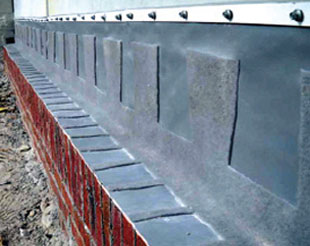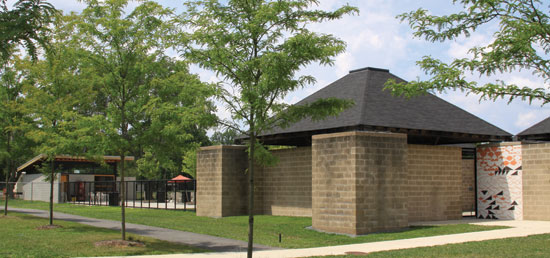Moisture Management in Masonry Buildings
As architects explore new forms: curved walls, canted overhangs, multifaceted edges, and masonry cladding in high-rise buildings, the integration of materials for moisture proofing wall systems can be an important design component. Three-dimensional detailing as part of information modeling has helped develop a more focused look at the many corners, breaks, and openings in modern buildings. “Designers sometimes forget how beautiful details are!” says Jim Stevens, AIA, an associate professor of architecture at Lawrence Technological University. Stevens reports that the plans for the renovation of a courthouse in St. Louis displayed corner boots, end dams, and flashing pieces that could have been exhibits of modern sculptures. A review of the components in wall flashing will show how unifying the components allows for easier installation and better moisture control in buildings.
Moisture and Masonry
 |
Unitized flashing systems can be specified using any of the most common flashing materials. Photo courtesy of Mortar Net® USA, Ltd. |
Masonry is a porous material and all masonry buildings absorb moisture. From roof to foundation, what may appear to be an impenetrable building component is in fact, a system that needs to breathe to expel moisture. Masonry walls are typically constructed with an air gap between the brick veneer or exterior wythe of brick and the structural wall. Brick veneer is primarily decorative and is connected to the structural wall system by metal brick ties. Between the veneer and the structural wall is an air gap that is the “lungs” of the wall system— the place where air and moisture is channeled to be expelled at any place where the solid wall is interrupted by an opening such as a window, an interior or exterior corner and primarily at the end of the vertical wall. The Brick Industry Association (BIA) defines a cavity wall as having a continuous air space. Depending upon the skill of the mason, mortar droppings can fill a wall cavity so the BIA recommends a 2-inch minimum cavity to allow for proper drainage and airflow. However, the BIA Technical Note 21A allows rigid insulation to occupy one-half of the 2-inch cavity creating an even tighter allowance for proper mortar placement.
 |
New Jersey’s Louis I. Kahn Trenton Bath House uses a unitized flashing system on two new walls. Photo courtesy of Mortar Net® USA, Ltd. |
The most common reasons for excess water in a brick wall cavity can come from:
- Inadequately filled or over-sanded mortar joints
- Extreme acid cleaning
- Design details – Rowlocks or Soldier courses
- Construction materials – weather exposure
A publication of best practices from the 2006 AIA Convention, describes the need for considering moisture penetration as part of an early design phase. “Effective prevention involves implementing a successful water management system, understanding the sources of moisture ingress, and identifying potential problems. Studies have shown that uncontrolled rainwater penetration and moisture ingress are two of the most common threats to the performance of a building's envelope and together they represent up to 80 percent of all construction-related liability claims in the United States.”2 Detailing of the drainage system through proper flashing is considered one of the top means of effective moisture management.
Effective Flashing
Flashing is a membrane installed within a masonry wall to either prevent moisture infiltration, or divert moisture, which does penetrate the wall, back to the exterior of the building. Flashing provides a controlled path for water through walls. Unless specified as a unified component, the pieces that comprise a flashing system are membranes, weeps, termination bars, drip edges, and adhesives. Driving rain or sleet and the build-up of condensation on the interior of a masonry wall is directed by gravity to the lowest point in a building. Without flashing, the collection of moisture increases maintenance costs and can even cause building failures. Water can be prevented from getting out of a wall by the omission or incorrect installation of wall flashing and weep holes that can be clogged by mortar. Damage to masonry buildings due to moisture penetration can include efflorescence, spalling, steel stud failures, mold penetration, and even the collapse of the entire wall system.









